The purpose of this page is to outline the key
considerations when planning a strength and conditioning training programme for
an athlete. Matching the programme to
the athlete and integrating it effectively with swim training requires a good
understanding of the sport, the types and volumes of training, the athlete and
a strong communication pathway between the three parties.
Every athlete has his or her own particular strengths and weaknesses, physical abilities, maximal effective training loads and lifestyle demands. Understanding the athlete is critical to maximise the effectiveness of the training programme.
Strength and Conditioning (S&C) involves the planning and implementation of physical preparation programmes aimed at enhancing the specific fitness components required to improve sports performance.
This
broad definition, which incorporates all aspects of physical conditioning (i.e.
strength, speed, power, endurance, flexibility, injury prevention etc),
overlaps considerably with the task of the swim coach, who has overall
responsibility for the physical, technical and psychological preparation of the
athlete. The success of the whole
programme, as measured by swimming performance,
is therefore dependant
on the swimming and S&C programmes complimenting each other. This will not
occur by chance. It must be driven by strong communication between the swim
coach, the strength & conditioning coach and the athlete.
The swim coach will lead this communication triangle, as they are responsible for leading the whole programme.
The role of
the S&C coach is to support the swimming coach through planning and
implementing a strength and conditioning training programme that compliments
the swim programme.
It is crucial that the swimming coach and S&C
coach have clearly defined roles and that the two forms of training are used to
target the specific fitness qualities that the athlete requires. Swim training clearly provides the most
specific method of developing the athletes’ cardiovascular and metabolic
(energy producing) systems, while land based training provides an excellent
method of overloading the neuromuscular system, it is worth noting it may also
target cardiovascular and metabolic systems depending upon the requirements of
the athlete.
Ultimately
the S&C programme must contribute to improving performance in the pool
The aims of this chapter are to:
1.
Provide guidelines for
the process of integrating the swimming and S&C programmes.
2.
Provide an overview of the principles of strength training as they
relate to swimming.
3.
Provide a typology of strength training, including clear terminology and
definitions of different types of strength training and the physical
adaptations that they stimulate.
4.
Provide general guidelines on the planning and organisation of strength
training.
INTEGRATING SWIM TRAINING AND S&C
British Disability Swimming has a
strong relationship with the Home Institutes of Sport that service the World
Class programmes. Athletes have different amounts of contact time with
Institute S&C coaches depending on their training plan, their level of
experience and their strength and conditioning needs.
The delivery process is as follows:
- S&C coach meets with the coach and athlete to start the communication process. The coach leads the process.
- S&C coach observes the athlete swimming.
- S&C coach performs full analysis of the athlete prior to planning the S&C programme.
- S&C coach collaborates with the swim coach and athlete regarding the proposed programme.
- S&C coach delivers designated workouts.
- The S&C plan will account for any workouts that are not designated to the S&C coach to deliver.
- The S&C coach and swim coach are in regular contact (minimum fortnightly) to discuss progress. The swim coach leads this process.
- S&C
coach furnishes a quarterly report to the S&C lead detailing the
athlete’s progress.
PRINCIPLES OF STRENGTH TRAINING FOR SWIMMING
Before considering the specific types of strength training that are appropriate for athletes, we should first recap the key principles of strength training as they relate to swimming.
As
discussed in the biomechanics section of this handbook, elite athletes
generally have superior stroke lengths compared
to non-elite athletes while stroke rates are similar. Thus technique work in the pool should emphasise
increasing stroke length (assuming a reasonable stroke rate can be
maintained).
Greater stroke length is achieved by:
Increasing propulsive forces without (or to a greater extent than) resistance forces.
Reducing resistance forces without (to a greater extent than) propulsive forces.
Strength
training can play an important role in both increasing propulsive forces and
reducing resistance forces.
Strength Training to Improve Propulsion
Strength training provides an effective method of overloading the neuromuscular system to increase force production and/or movement velocity (speed). To understand the role that different types of strength training can play and how they relate to swimming, it is important to consider the following key concepts:
The force-velocity curve.
The rate of force production.
The stretch-shorten cycle.
The Force - Velocity - Power Curve
The ability to
apply large forces and the ability to move at high speeds (velocities) are
different yet highly interdependent motor abilities. As the force-velocity curve (figure 1)
illustrates, the velocity at which a muscle can generate force is inversely
related to the amount of force required and visa versa. As the force
required for a particular movement (e.g. moving an arm through water or lifting
a weight) increases, the velocity of execution decreases. An example of this is
when lifting a heavy object, high force is required but the speed of movement
is low.
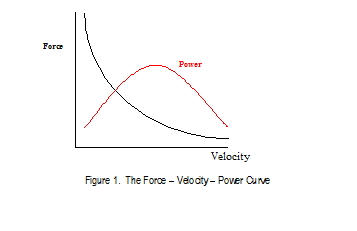
Power = Force x Velocity
Maximum power output (figure 1) is usually achieved between 30-50% of the individual’s maximal force, depending on the individual and the movement. However, an athlete’s maximum power output is not necessarily the optimal power output for swimming. Optimal power output refers to the optimal balance of force and velocity of movement, which is complicated by the fact that the forces are applied to a fluid surface. When applied to a solid surface (such as the ground or blocks), an increase in power output (i.e. force and/or velocity) the athlete produces in a particular task will result in an increase in propulsion and improvement in performance because the resultant force created at the surface is predictable (see biomechanics chapter). Thus, an increase in power output when pushing off during diving and turning will improve performance in these skills. However, the effects of applying greater force or movement velocities during the stroke are dependant on the change in the propulsive drag or lift created at the surface of the hand/arm as a result.
If increasing the force and/or movement velocity, the athlete applies to the water means the limb simply ‘slips’ through water without increasing the lift/drag that is created, it will not contribute to propulsion. In this case, the extra work performed will simply reduce the athlete’s efficiency and may ultimately inhibit performance. Similarly, if increasing force/limb velocity through the water reduces the athlete’s ability to ‘grip’ the water to the extent that it reduces propulsive lift/drag, this will also inhibit performance. Hence, it is the athlete’s technical ability to apply additional power output in a manner that increases propulsive drag/lift that determines the additional propulsion that is created (see biomechanics chapter).
From this two situations may occur:
- An athlete with higher technical ability compared with physical capacity, resulting in a sub optimal performance due to physical restrictions.
- An athlete with a higher physical capacity than technical ability resulting in sub optimal utilisation of physical capacity due to restrictions in technique.
It may therefore be argued that in a sport specific capacity an athlete cannot be too powerful or too strong, if this is identified it may be the technique of the athlete that is limiting performance, specifically the ability to access this extra physical capacity they obtain.
Further to this an athlete with a higher maximum
power will be able to sustain a relatively lower percentage, with an increased
absolute power compared to an athlete with lower maximum power output resulting
in superior power endurance.
Rate of Force Development (RFD)
It takes a muscle approximately half a second (500 ms) of contraction time to reach its maximum force generating capacity. Yet, most sports (including swimming) require significantly more rapid movements, which allows the athlete very little time to generate force. Therefore RFD, which refers to the ability to apply force rapidly when movement time is short, is also an important factor when considering strength training for athletes.
The difference between RFD and max force is illustrated in Figure 2. In skills that require high forces to be applied very rapidly (e.g. high jump take-off) athlete B has an advantage, as they are able to apply more force in the first 200-300ms of the action. Yet, in sports that require high forces to be applied over longer periods of time (e.g. powerlifting) athlete A has the advantage, as they are able to apply a greater total force.
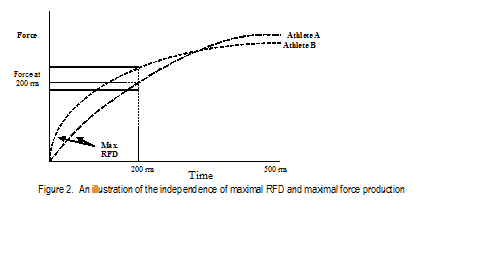
Thus, the optimal combination of force, velocity and RFD depends on the sport, or particular skill that is performed and is referred to as sport-specific strength. In sports such as swimming, where movements must be performed continuously for an extended period of time, sports specific strength also includes an endurance component.
Strength training, in its many guises, is an
excellent method of developing these key strength qualities (i.e. maximal force
production, movement velocity, RFD and strength endurance). Ultimately, there is no single test of the
optimal combination of the different strength qualities each athlete
requires. Identifying this optimal
combination and the decision about how to achieve it is the task of the
swimming and S&C coaches. This does
not mean that strength training should only involve exercises that attempt to
replicate the particular strength profile involved in sports specific
strength. The strength-training
programme must be designed to optimise sports specific strength at the time of competition. This is best achieved by overloading the
different strength qualities at different times in accordance with the goals of
the overall swimming programme.
The Stretch-Shortening Cycle
Having identified the components that contribute to optimal sports-specific strength, it is also necessary to consider the key types of muscle actions that take place during swimming. Weight bearing sports (such as running and jumping) require the athlete to repeatedly absorb forces during landing, and then rapidly generate force to propel the body in another direction during take-off. This process of absorbing forces through stretching (or eccentrically contracting) the muscle followed by shortening (or concentrically contracting) the muscle is known as the stretch-shorten cycle (SSC). This is evident in swimming during starts and turns and during the swimming stroke (unloaded compared to starts and turns), where during hand entry the active muscles of the upper body are placed on stretch prior to the commencement of the stroke.
The large eccentric (stretching) forces created during the eccentric phase of the SSC generates a form of ‘elastic energy’ in the muscles and tendons, much like stretching an elastic band, which can be utilised by the athlete to enhance the force, velocity and RFD achieved during the concentric (shortening) phase. This ‘elastic energy’ effectively acts as an extra source of energy, which can be used to increase power output and reduce the energy demands placed on the metabolic and cardiovascular systems, thus increasing an athlete’s efficiency. This is referred to as reactive strength, and is an important quality in starts and turns during swimming; the swimming strokes do not involve such a high loaded eccentric movement immediately prior to the concentric movement therefore the stroke will require more concentric strength, however SSC will play a role in improving the strokes performance.
This highlights
a potential distinction between the types of strength training used to improve
performance in starts and turns and in swimming itself. Optimising the force, velocity, RFD and
strength endurance in the concentric phase of the movement, is the primary
concern when developing strength training programmes to enhance actual swim
performance, whereas, reactive strength and RFD are important when the goal is
to improve starts and turns.
Types of Strength Training and their Effects on Different Strength Qualities
Maximal Strength and Power
The figures below illustrate the effects of two different types of strength training, namely, maximal strength (or heavy) training and explosive strength/power training on force, velocity and RFD.
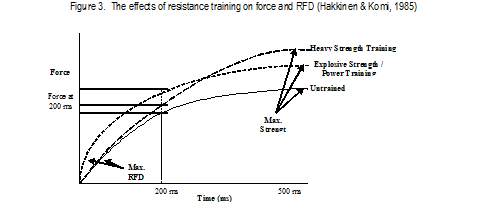
Figure 3 reveals that heavy strength training results in an increase in maximum strength but has no effect on RFD in the first 200ms of muscle action. Explosive strength/power training, on the other hand, induces less improvement in maximal strength but greater improvements in RFD.
Figure 4 illustrates how these types of training effect the force-velocity relationship. Heavy strength training increases the athletes force production during slow movements, but not during fast movements. Whereas, explosive strength training increases force production during high velocity movements, but has little effect during slow movements.
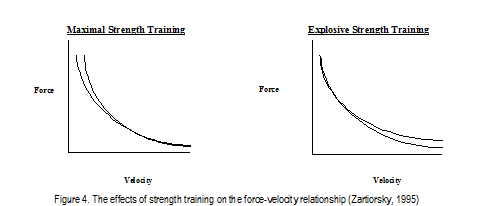
However, this does not fully explain the role of strength training. More specifically:
It does not demonstrate the highly inter-related nature of maximum strength and explosive strength/power training.
It does not consider the role of strength endurance (i.e. the need for skills to be reproduced continuously or intermittently for extended periods of time), which is crucial in sports such as swimming (see discussion on strength endurance below).
In fact, maximal strength (i.e. the ability to apply large forces) is a key ingredient that underpins explosive strength (i.e. the ability to apply large forces at high speeds). Clearly, without high levels of maximal strength the athlete will never maximise their explosive strength.
Training must therefore focus on developing maximum strength before, or alongside increases in explosive strength. However, while maximal strength is an important factor it is important to consider all of the key aspects of sports specific strength.
So far in this discussion we have only briefly referred to the need to maintain or repeat movements continuously for extended periods of time, yet this strength (or more accurately power) endurance is a major component of optimal sports specific strength in swimming.
Developing maximal strength, power and RFD beyond the level that is optimal for a single stroke assists endurance performance as it provides a ‘strength reserve’, which means the athlete is not required to work at close to their maximum power generating capacity for the whole race, see figure 5.
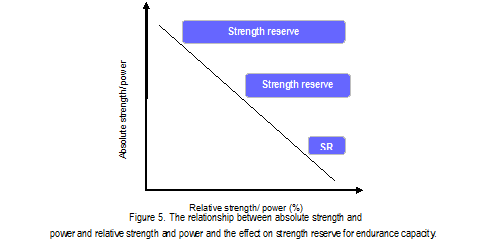
To maximise training efficiency, it is widely argued that strength training should be used only to develop maximum force production, movement velocity and RFD and that this will be transferred into the sports-specific endurance required through swim training. This is a valid approach, particularly for those in the early stages of strength training or for whom maximal force production, velocity or RFD is a key limitation to swim performance. However, for more advanced athletes or those for whom these maximum strength qualities do not limit performance, strength endurance and/or power endurance training may enhance the transfer of these strength qualities into swim performance as it is an effective method of overloading the neuromuscular system to a greater extent than swim training alone.
Consequently, the swimming coach and S&C coach must consider both the optimal combination of the strength qualities the athlete requires for each stroke and the optimal ‘strength reserves’ that are required for the event. This provides the basis for balancing the need for the different types of strength training with swim training, recovery time and the athlete’s lifestyle.
Strength Training to Reduce Resistance Forces
As mentioned previously, strength training may also
play a role in minimising the resistance forces that slow the athlete down. Resistance forces are a result of viscous,
wave and form drag, which are partly dependent on the size, shape and
disability of the athlete (see biomechanics chapter of this handbook for a more
detailed discussion).
Strength training can minimise the negative effect of wave and form drag in two ways:
Increasing the power output produced when starting and turning, thus maximising the use of the out-of-water and underwater phases of a race.
Improving postural control of the ‘core’ (i.e. the hips-pelvis-trunk-shoulder girdle axis) during swimming to assist the athlete in achieving the optimal alignment of the body throughout the stroke.
The first of these is effectively a result of
improved propulsive force and is therefore covered by the discussion previously;
however, the second point deserves more attention.
It has long been recognised that athletes need to
maintain a ‘streamlined’ position in the water in order to minimise wave and
form drag. However, optimal
‘streamlining’ does not involve simply holding the body in an extended position
on the surface of the water and is probably dependent on the individual stroke
characteristics of the athlete.
Essentially, the athlete must place their body in the position that
allows the limbs to maximise the propulsive force they are able to generate
while minimising resistive drag.
Obtaining the optimum ‘streamlined’ position is
primarily a matter of technique to be dealt with during swim training rather
than S&C. However, strength training
can play an important role in helping the athlete develop the underlying
physical capability to perform the movements required and therefore, assists in
the pursuit of optimal swimming technique. It is therefore vital that the
S&C coach has an understanding of the individual’s swimming style and
constraints of the athlete.
‘Core Stability’ and Athleticism
The concept of core
stability has become very popular recently,
however this is a loosely defined concept frequently applied to a host of means
and methods of training the trunk or mid-section of the body. Its popularity stems from recognition of the
fact that the trunk (i.e. core) plays an important role in controlling and
transferring forces through the body and therefore contributes to the
production of skilled and powerful movements.
The recent upsurge in popularity of ‘core stability’ training has
resulted in over-exaggerated claims of its benefits and a plethora of new
training tools (from Fit Balls to Electro-stimulation devices), which has
led sceptics to dismiss it as just another ‘fad’. However, the underlying concept of developing
the ability to control and channel forces effectively throughout the kinetic
chain to maximise movement efficiency is important to all ports (Burg,
2006). As this suggests, stability is
relevant to the functional ability of all joints. Therefore stability training should not be
limited to the abdomen and back; nor should it be limited to developing fine
motor control of the small postural muscles as is often prescribed. It requires the presence of both:
The physical awareness and fine motor control to position the joints in the optimal position for smooth powerful movements to take place. This may require some joints to be fixed or held in position statically, while others are involved in dynamic tracking movements.
The strength & endurance to fix and/or move the joints as necessary while effectively controlling and channelling the high forces produced by powerful movement of the limbs.
These two components are clearly not mutually exclusive and the concept in its broadest sense should therefore be seen as a form of whole body movement control and will be referred to as simply Stability Training. Poor stability allows some of the forces produced during the stroke to be misdirected through the kinetic chain resulting in both:
Loss of power, timing, control and overall effectiveness of the skilled movement.
Increased injury potential due to large forces being applied to tissues that are not built to deal with them.
Developing good stability may, therefore, be
equally, if not, even more important than optimal sports specific strength, and
should form an important part of every athlete’s programme. This is particularly the case for athletes as
the lack of a stable surface with which to create a base of support places
considerable emphasis on the ‘core/trunk’ region (i.e. hips, pelvis, spine and
shoulders) as the base from which the limbs generate force.
The need to
develop general Athleticism is another very broad concept
that is commonly referred to by swimming coaches.
Athleticism
consists of several components, namely:
- General whole body stability.
- Basic strength and power.
- Flexibility and mobility.
- Linear, lateral
multi-directional and rotational movement.
Athletes are athletes, and like all athletes, good general athleticism provides the foundations on which to develop the more specific physical and technical qualities required for swimming. Therefore, not all exercises have to mimic the swimming stroke to be effective. Many common strength exercises can be used to develop general stability and athleticism but are not functionally specific for swimming. The overhead squat, for example, is a good method of developing leg and trunk strength and stability around the hips, pelvis, spine and shoulders under high loads. However, it requires the pelvis, spine and shoulders to be fixed in the ‘neutral’ position, which is not the optimal ‘streamlined’ position for swimming. It is, therefore, important to utilise a range of general exercises and more functionally specific exercises to develop the qualities required for swimming.
Stability training, like all forms of training, should be individualised to target both the athlete’s individual weaknesses and the functional demands of the stroke. This involves identifying the optimal positions and movements the athlete performs through the stroke, developing a variety of general and more specific exercises and organising them in a gradual and progressive manner to develop these attributes. The starting point should mildly challenge the athlete’s ability to control the movement, then the complexity, intensity, and functional specificity should be increased gradually. Hence stability-training can described using the following three scales:
- Intensity: the load or speed of the movement.
- Complexity: the number of joints and/or muscles involved in the movement and the difficulty of the co-ordination patterns required.
- Functional
Specificity: the similarity of the exercise to the sports requirements.
Strength Training and Body Size/Shape
As discussed, resistance forces are partly dependent on the size and shape of the athlete, which can be altered as a result of strength training. It is a widely held misconception that strength training automatically causes athletes to ‘bulk up’, which increases resistive drag and may slow the athlete down. However, although strength training can be used to increase an athlete’s muscle mass, this is not the case for all forms of strength training. Strength training is a very effective method of targeting the nervous system. Hence improvements in force production; movement velocity and RFD can be achieved through improvements in muscle size and functional capacity and/or the ability to recruit and co-ordinate the firing of the nervous system. Increases in muscle mass can be achieved through ‘hypertrophy training’ (commonly referred to as bodybuilding); while improvements in relative strength and power (i.e. increasing the ability to apply force and power without increasing muscle mass) can be achieved through more ‘neural’ types of training such as maximal strength, explosive strength and power training (see section 11.8. for more details).
Strength Training and Injury Prevention
Strength training has to improve the athlete’s performance in the pool. However, this can be done directly, through maximising propulsive and minimising resistance forces, and indirectly, through helping the athlete to cope better with training in the pool and preventing time lost as a result of injury. To achieve this, appropriate exercises aimed at improving the athletes general stability and athleticism along with those aimed more specifically at improving key areas such as the shoulder and lower back, should be built-into the athletes overall strength training programme as appropriate.
Due to the high volume of swim training performed the shoulder goes through approximately 500,000 revolutions per arm per season which can lead to common overuse injuries. The optimal method to counteracting this high volume is to perform a high volume of pre-habilitation work to reduce the risk of potential overuse injuries occurring. Periods to perform this training can be in and around pool sessions such as pre and post pool sessions, which is a time effective method to include vital training volume.
General Strength and Athleticism vs. Functional Specificity in Strength Training
The previous discussion on the development of stability and athleticism raised the controversial issue of functional specificity in exercise selection. This issue has a tendency to polarise coaches into two camps:
1. Those who recommend that general strength training exercises should be used as they provide both the greatest overload for the neuro-muscular system and improve the athlete’s general ‘athleticism’ (i.e. physical awareness and co-ordination).
They argue that swimming training provides the necessary stimulus for these improvements in strength and general athletic ability to be transferred into swimming performance.
2. Those who believe that general strength exercises are not ‘specific’ enough for the gains to be transferred into swimming performance and that strength training exercises must mimic as closely as possible the functional demands (i.e. body position, limb movements, muscle actions etc.) that are performed during swimming.
However, the efficacy of relying solely on either approach can be criticised. The use of general exercises to improve strength and/or overall athleticism fails to maximise the transfer of these gains into performance (Wathan, 2000). Yet, the use modified of exercises that mimic the functional demands of the sport limits the load that can be used, thus, failing to overload the neuromuscular system adequately and may actually interfere with timing and coordination of the skilled movements (Bennie, 2005; Cleaver, 2006).
Ultimately, strength training must transfer into performance gains in the pool and most transfer will occur through performing exercises that are functionally similar to swimming. However, to maximise the effectiveness of these exercises, it is necessary to first develop the basic neuromuscular and physical qualities that are to be transferred. Consequently, strength and stability programmes should focus on developing a good background of general stability and athleticism before working towards developing the more ‘functionally specific’ attributes required for swimming. This highlights the need for a range of methods to be incorporated into the strength training programme, and for the integration and progression of these to be well planned and organised.
The large number of variables that
need to be considered when designing resistance training programmes has resulted
in the development of numerous ‘types’ of strength training. However, different terms are often used to
describe types of training aimed at eliciting the same basic physical and
physiological adaptations and/or the same terms are used to describe those
eliciting different adaptations. To cut
through this confusion we will use the classification framework (typology) outlined
in table 1 (see section 11.8.).
A TYPOLOGY OF STRENGTH TRAINING FOR SWIMMING
These
‘types’ of strength training each has a different primary objective and result
in different biological and functional adaptations. There is some overlap between the different
types of training, especially for athletes with a low training age, thus,
designing a workout aimed at inducing a single biological or functional
adaptation is not possible. It is
possible, however, to target the primary adaptations associated with each
training type. Furthermore, most of the
example exercises can be used as both SSC and concentric only to target
adaptations required.
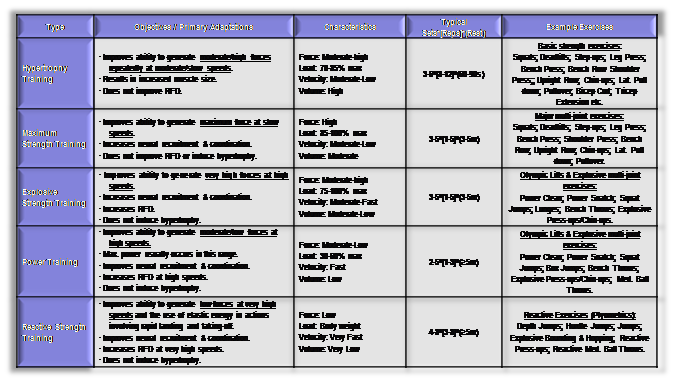
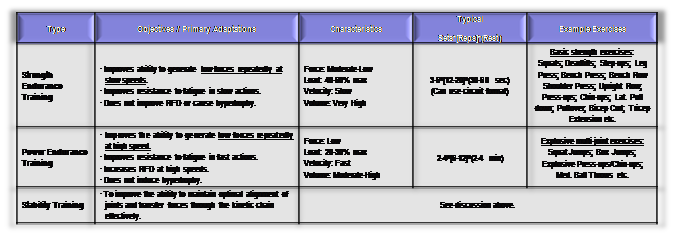
Notes:
- Not all of the example exercises will be appropriate for every athlete; however, most can be adapted to suit the physical abilities of the athlete. This should be done with guidance from the S&C coach.
- The majority of the example exercises can be adapted to be performed as either SSC, concentric only or eccentric only exercises, depending on the adaptations targeted.
- As many S&C training sessions should be supervised by the S&C coach as possible.
GUIDELINES FOR THE PLANNING AND ORGANISATION OF STRENGTH TRAINING FOR SWIMMING
The first consideration when designing a strength training programme is the athlete’s physical status. An initial assessment must be conducted prior to the start of the programme and must include a practical assessment of the athlete to identify their particular physical abilities, strengths and weaknesses and a discussion with the athlete and coach to identify relevant factors.
The physical status and rate of progress of every athlete will differ considerably and will dictate the organisation and content of the programme. However, there are a number of basic principles that should help guide the strength training programme:
- The development of general stability and athleticism should precede the targeting of specific strength qualities. In the early stages of strength training, most athletes would benefit from devoting time to developing their general stability and athleticism. Use of a range of activities is encouraged as this will help develop a range of strength qualities at this stage and provides a solid foundation on which to build.
- The athlete must demonstrate the stability required to perform an exercise consistently with good technique before the complexity (i.e. number of joints involved, level of mobility) and/or intensity (i.e. load or speed) of the movement are increased.
- Although significant individual variability exists in the extent and time taken for individuals to respond to training, programs should retain the focus on developing general athleticism and maximal strength for some time in order to maximise the adaptation.
- As progress occurs, improvements in strength qualities become increasingly difficult to achieve. As a result, the strength programme will need to prioritise the strength qualities to be developed and focus on 1-2 at any one time.
- As the benefits gained from general strength and stability exercises diminish, the potential advantages of more functionally specific exercises increase. Therefore, the functional specificity of the strength training programme should be increased over time.
- This does not mean that training aimed at developing general stability and athleticism should be eliminated for experienced athletes. It is advisable to re-visit these types of training during the preparatory periods of training cycles. However, the volume of training required to maintain these physical attributes is lower than that required to develop them initially (Mckardel et al., 2000). Thus, more emphasis can be placed on developing optimal sport specific strength and more functionally specific exercises both as the athlete progresses through each training cycle and over successive training cycles.
In sum, athletes
need to develop a range of strength qualities with the goal of improving
optimal sport specific strength and stroke efficiency. A comprehensive strength training programme
should follow a continuum of increasing complexity, intensity and specificity to
a level appropriate for the individual at any given time.
SUMMARY
It is
often cited that strength training is able to help athletes improve their
starts and turns, maintain a streamlined position in the water and prevent
injury but does not contribute directly to propulsion during swimming itself on
the basis that:
Swimming takes place in a fluid medium, which limits the effectiveness of developing high levels of force production, movement velocity and RFD to the athlete’s technical ability to ‘hold’, or prevent the limb ‘slipping’ through the water.
The swimming stroke is primarily concentric, whereas typical strength training exercises utilise the SSC.
Strength training increases the athlete’s body mass (muscle mass), which increases resistance in the form of wave and form drag.
Strength training is a short-duration activity lasting 10 seconds or less that helps develop the anaerobic (alactic and lactic) energy systems, whereas swimming is an endurance activity in which even the shortest events take longer than 20 seconds (e.g. Jones, 2003)
It is intended
that this discussion:
- Reinforces the assertion that strength training is a useful method of improving performance at starts and turns, preventing injury and assisting the athlete in maintaining the optimal body position throughout the race.
Highlights the potential for the strength training programme to contribute directly to propulsive force through using a combination of SSC and concentric only exercises to target the optimal combination of the key strength qualities - force, velocity, RFD, and endurance - without creating unnecessary additional body mass.
In fact,
strength training has the potential to enhance swimming performance if used
correctly. However, integrating the
different types of strength training with swimming training is a complex
process that requires consideration of a number of factors, including:
The strength characteristics (force, movement velocity, RFD, and endurance requirements) of the event.
The athlete’s particular physical abilities, strength characteristics, swimming technique, training experience and maximal effective training load.
The swim training programme

